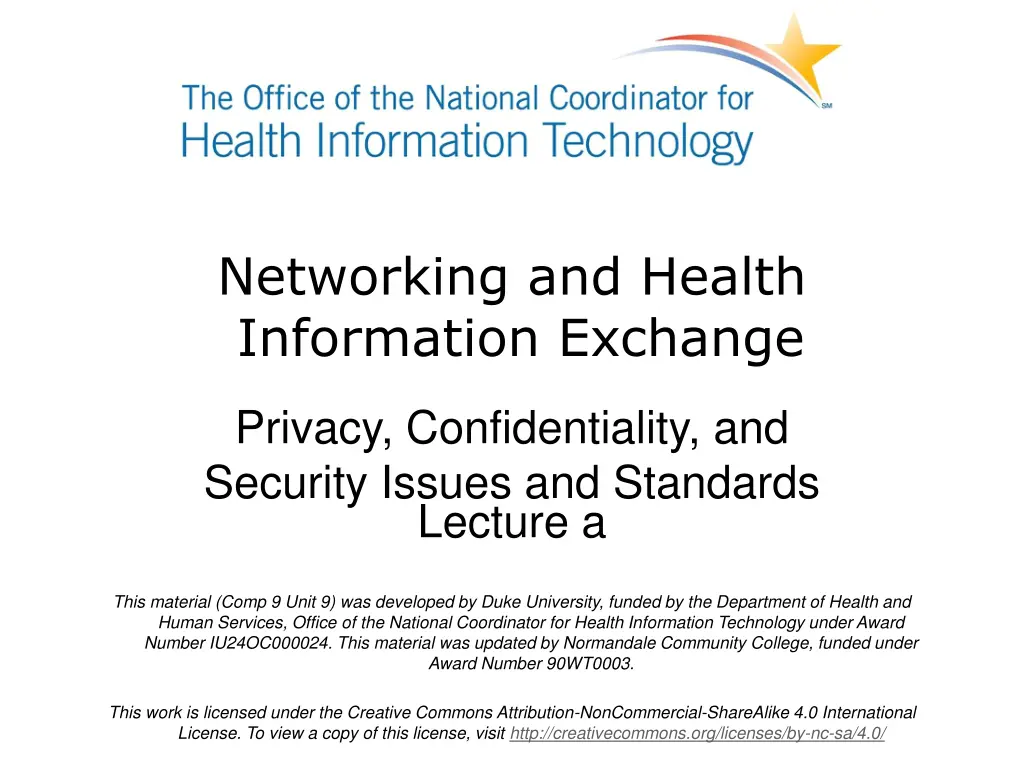
Understanding Privacy, Confidentiality, and Security in Health Information Exchange
Explore the importance of privacy, confidentiality, and security in health information exchange, covering key concepts, security measures, and legal regulations like HIPAA. Learn about safeguarding data and ensuring compliance with standards.
Download Presentation

Please find below an Image/Link to download the presentation.
The content on the website is provided AS IS for your information and personal use only. It may not be sold, licensed, or shared on other websites without obtaining consent from the author. If you encounter any issues during the download, it is possible that the publisher has removed the file from their server.
You are allowed to download the files provided on this website for personal or commercial use, subject to the condition that they are used lawfully. All files are the property of their respective owners.
The content on the website is provided AS IS for your information and personal use only. It may not be sold, licensed, or shared on other websites without obtaining consent from the author.
E N D
Presentation Transcript
Networking and Health Information Exchange Privacy, Confidentiality, and Security Issues and Standards Lecture a This material (Comp 9 Unit 9) was developed by Duke University, funded by the Department of Health and Human Services, Office of the National Coordinator for Health Information Technology under Award Number IU24OC000024. This material was updated by Normandale Community College, funded under Award Number 90WT0003. This work is licensed under the Creative Commons Attribution-NonCommercial-ShareAlike 4.0 International License. To view a copy of this license, visit http://creativecommons.org/licenses/by-nc-sa/4.0/
Privacy, Confidentiality, and Security Issues and Standards Learning Objectives Explain the concepts of privacy and confidentiality requirements and policies and learn how to implement the requirements. Describe how to secure data storage and transmission using data encryption, signatures, validation, non-repudiation, and integrity. (PKI, certificates, and security protocols). 2
Security Defined The quality or state of being secure Freedom from danger Freedom from fear or anxiety Measures taken to guard against espionage or sabotage, crime, attack, or escape 3
Information Security Protecting information and information systems (including computers, computing devices and networks) from: Unauthorized access Unauthorized use Unauthorized alterations Unauthorized interruptions Devastation 4
Key Security Concepts Confidentiality Integrity Availability Accountability Nonrepudiation 5
Confidentiality Confidentiality is making sure that only authorized individuals have access to information. It is also making sure that individuals with access keep the information private and do not share with others. There are Federal and State laws in place to protect patient confidentiality, and punish those who abuse confidentiality. 6
The Health Insurance Portability and Accountability Act (HIPAA) Protects health insurance coverage for workers and their families when they change or lose their jobs. Requires the establishment of national standards for electronic health care transactions and national identifiers for providers, health insurance plans, and employers. 7
HIPAA Continued Addresses the security and privacy of health data. Encourages the widespread use of electronic data interchange (EDI) in the U.S. health care system. 8
Integrity Integrity means that the data in a system is the same as the data from the original source. The data has not been altered or destroyed, intentionally or unintentionally. 9
Encryption Plaintext + Cipher = Ciphertext 10
Example Cipher = Shift characters x amount to the y Plaintext = Hospital X= 3, y = right Ciphertext = KRVSLWDO X=4, y=left Ciphertext = DKOLEPWH 11
Types of Encryption Symmetric Same key used to encrypt and decrypt Shared key Asymmetric One key used to encrypt and another key used to decrypt Public key encryption 12
Hashes A number that is generated based on the data If the data has been altered in any way then the hash will be different Also called a message digest or simply a digest 13
Availability Means that the system/data is available when needed Fault-tolerance Denial of service (DoS) 14
Accountability Accountability is the process of holding a person/entity responsible for his actions. System must Identify users Maintain audit trail of actions 15
Nonrepudiation Provides Proof Origin o Digital signatures o Private keys (asymmetric encryption) Delivery o Return receipts 16
Public Key Infrastructure (PKI) Certificates Also called digital or identity certificates Public keys Certificate Authority (CA) Registration Authority (RA) Revocation Certificate Revocation List (CRL) 17
Certificates Image courtesy of Tracy Mastel 18
Certificates Continued Image courtesy of Tracy Mastel 19
Privacy, Confidentiality, and Security Issues and Standards Lecture Summary Concepts of privacy and confidentiality How to secure data 20
Privacy, Confidentiality, and Security Issues and Standards References Lecture a References References were not used for this lecture. Images Slide 10: Encryption. Courtesy Michele Parrish. Used with permission. Slide 18: Certificate. Courtesy Tracy Mastel. Used with permission. Slide 19: Certificate Info. Courtesy Tracy Mastel. Used with permission. 21
Privacy, Confidentiality, and Security Issues and Standards Lecture a This material was developed by Duke University, funded by the Department of Health and Human Services, Office of the National Coordinator for Health Information Technology under Award Number IU24OC000024. This material was updated by Normandale Community College, funded under Award Number 90WT0003. 22






















